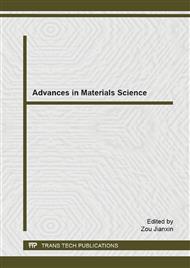[1]
R.G. Candido, Utilização da celulose de resíduos lignocelulósicos para obtenção de produtos de alto valor agregado. Dissertação de mestrado. Escola de Engenharia de Lorena. Universidade de São Paulo. Lorena/SP, (2011).
DOI: 10.11606/d.97.2011.tde-22082013-161627
Google Scholar
[2]
M.S. Silveira. Aproveitamento das cascas de coco verde para produção de briquetes em Salvador-BA. Dissertação (Mestrado em Gerenciamento e Tecnologias Ambientais no Processo Produtivo). – Universidade Federal da Bahia. Escola Politécnica. 163 p. Salvador-BA. (2008).
DOI: 10.22239/2317-269x.01844
Google Scholar
[3]
I.D. Valarelli R.A.G. Battistelle; M.A.P. Bueno B.S. Bezerra; C.I. Campos; M.C.S. Alves. Physical and mechanical properties of particleboard bamboo waste bonded with urea formaldehyde and castor oil based adhesive. Revista Matéria. v. 19, n. 01. Rio de Janeiro, (2014).
DOI: 10.1590/s1517-70762014000100002
Google Scholar
[4]
Brazilian Association of Technical Standards (ABNT) 14. 810-2. Particleboards - Part 2: Requirement and Test Methods. Brazil, ABNT Press (2013), p.107.
Google Scholar
[5]
T. García-Ortuño; J. Andréu-Rodrigues; M.T. Ferrández-Gracía; M. Ferrández-Villena, M.; C.E. Ferrández-Gracía. Evaluation of physical and mechanical properties of particleboard made from Giant Reed (ArundoDonax L. ). BioResources, Raleigh, v. 6, n. 1, pp.477-486, fev. (2011).
DOI: 10.15376/biores.6.1.477-486
Google Scholar
[6]
EUROPEAN COMMITTEE FOR STANDARDIZATION. European Standard EN 312- Particleboard - Specifications. Brussels: (2003).
Google Scholar
[7]
A.M. Lima. Utilização de fibras (epicarpo) de babaçu como matéria-prima alternativa na produção de chapas de madeira aglomerada. Rev. Árvore, Viçosa, v. 30, n. 4, pp.645-650, ago. (2006).
DOI: 10.1590/s0100-67622006000400018
Google Scholar
[8]
P.R.A. Passos. Destinação Sustentável de Cascas de Coco (Cocos nucifera) Verde: Obtenção de Telhas e Chapas de Partículas. Tese - Universidade Federal do Rio de Janeiro, COPPE- Doutor em Ciências em Planejamento Energético. 166 p. Rio de Janeiro- RJ. (2005).
DOI: 10.22239/2317-269x.01977
Google Scholar
[9]
A. Colli; Vital, B.R.; Silva, J.C.; A.M.L. Carvalho; R.M.D. Lucia. Propriedades de chapas fabricadas com partículas de madeira de paricá (Schyzolobium amazonicum Huber ex. Ducke) e fibra de coco (Cocos nucifera L. ). Revista Árvore. Viçosa-MG. v. 34, n. 2, pp.333-338, (2010).
DOI: 10.1590/s0100-67622010000200016
Google Scholar


